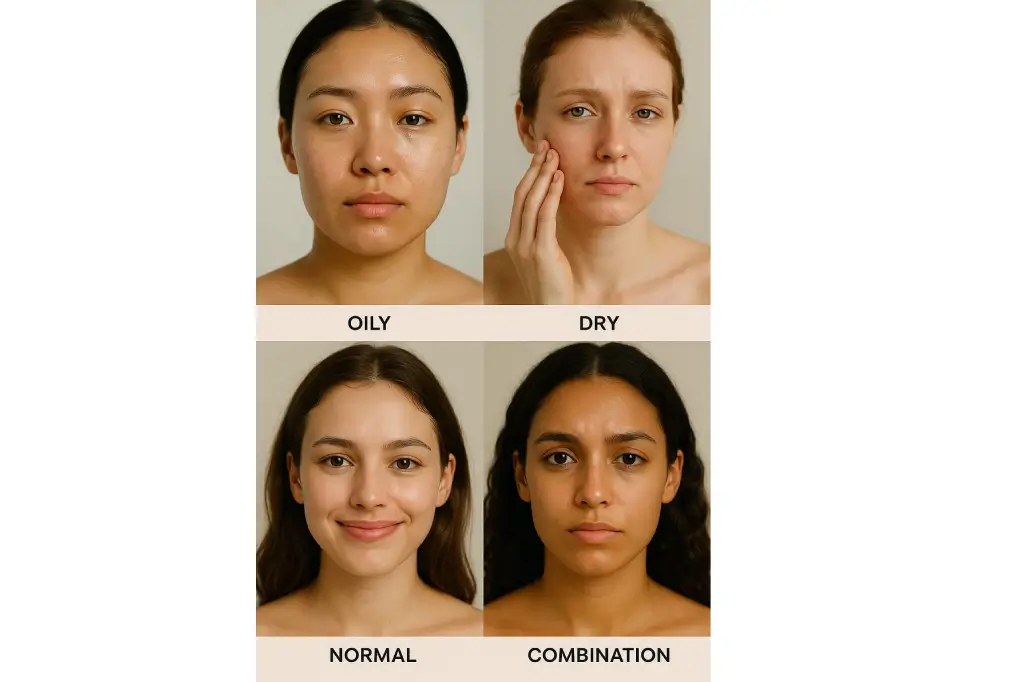All Skin Types: The Ultimate Guide to Identifying Your Skin Type

Contents
All skin types are unique, and you have probably wondered why your skin feels a certain way—sometimes dry, sometimes oily, or maybe a bit of both.
Just like we all have different personalities, our skin also has its own unique characteristics! Understanding what all skin types really mean and figuring out which one you have is the first exciting step to giving your skin exactly what it needs to look and feel its best.
Think of your skin as a special shield that protects your body. This shield is constantly working, and how it behaves depends on many things, like what you eat, where you live, and even your genes (what you inherit from your family).
There is not just one type of skin for everyone. In fact, there are several main skin types, and learning about them will help you choose the right products and routines to keep your skin happy and healthy.
Why Is It Important to Know Your Skin Type?
Imagine trying to water a plant without knowing if it needs a lot of water or just a little. You might give it too much or too little, and it will not thrive. The same goes for your skin! If you use products meant for oily skin when you have dry skin, your skin might become even drier. Or, if you use heavy creams on oily skin, you might end up with breakouts.
Knowing your skin type is like having a secret map to healthy skin. It helps you:
- Choose the Right Products: From cleansers to moisturizers, every product works best when it matches your skin’s needs.
- Create a Good Skincare Routine: You will know how often to cleanse, moisturize, and use special treatments.
- Solve Skin Problems: Understanding your skin type can help you tackle issues like dryness, oiliness, or sensitivity more effectively.
- Maintain Healthy Skin: A consistent routine tailored to your skin type helps keep your skin balanced and glowing.
Exploring All Skin Types
When we talk about all skin types, we are usually referring to five main categories. Let’s take a closer look at each one.
1. Normal Skin: The Balanced Beauty
Imagine skin that rarely feels too dry or too oily. It is smooth, clear, and has a healthy glow. This is normal skin! It is considered the most balanced type.
- How it feels: Comfortable, neither tight nor greasy.
- How it looks: Even tone, small pores (the tiny openings on your skin), and a radiant appearance.
- Common issues: Very few, if any, breakouts or sensitivities.
- Why it is normal: It has a good balance of oil (sebum) production and hydration.
- Care tips: Even though it is low-maintenance, normal skin still benefits from a consistent routine of gentle cleansing, moisturizing, and sun protection to keep it healthy and prevent future problems.
2. Dry Skin: Thirsty and Sometimes Tight
If your skin often feels tight, flaky, or rough, especially after washing, you might have dry skin. This type of skin does not produce enough natural oils to keep itself moisturized.
- How it feels: Tight, especially after washing, sometimes itchy or rough.
- How it looks: Dull, possibly flaky, fine lines might be more noticeable, and pores are often very small or invisible.
- Common issues: Prone to redness, irritation, and sometimes a feeling of discomfort. It can also be more susceptible to environmental factors like cold weather or dry air.
- What causes it: Less oil production, which means less protection against moisture loss.
- Care tips: The key for dry skin is hydration! Look for rich, creamy cleansers and thick moisturizers that lock in moisture. Avoid hot water and harsh soaps, as they can strip away essential oils. Drink plenty of water too!
3. Oily Skin: The Shiny Side
Do you notice a shine on your face, especially on your forehead, nose, and chin (often called the T-zone)? Do you sometimes get breakouts? You likely have oily skin. This skin type produces an excess amount of sebum, the natural oil.
- How it feels: Greasy or slick, especially as the day goes on.
- How it looks: Shiny, enlarged or visible pores, and more prone to blackheads, whiteheads, and pimples.
- Common issues: frequent breakouts, clogged pores, and a persistent shine.
- What causes it: Overactive oil glands that produce more sebum than needed. This can be influenced by hormones and genetics.
- Care tips: The goal for oily skin is to control excess oil without stripping the skin. Use gentle foaming cleansers and lightweight, oil-free moisturizers. Look for products labelled “non-comedogenic,” meaning they will not clog pores. Do not skip moisturizing—even oily skin needs hydration!
4. Combination Skin: A Mix of Worlds
If some parts of your face are oily (like your T-zone) while others are dry or normal (like your cheeks), you have combination skin. This is a very common skin type, making it a key part of understanding all skin types.
- How it feels: Oily in some areas (T-zone) and normal to dry in others (cheeks).
- How it looks: Visible pores and shine in the T-zone, while cheeks might be smoother or occasionally dry.
- Common issues: Breakouts in the T-zone and dryness on the cheeks can be tricky to manage, requiring different approaches for different areas.
- What causes it: An uneven distribution of oil glands across the face.
- Care tips: This type needs a balanced approach. You might use different products for different areas of your face. For example, a purifying cleanser for the T-zone and a slightly richer moisturizer for drier areas. Focus on gentle, balancing products that will not over-dry or over-moisturize.
5. Sensitive Skin: Easily Irritated
Does your skin often react to new products, certain ingredients, or even changes in weather? If it gets red, itchy, or stings easily, you probably have sensitive skin. This is not strictly a type like dry or oily, but rather a condition that can affect any of the other types. For example, you can have dry, sensitive skin or oily, sensitive skin.
- How it feels: Itchy, burning, stinging, or tight.
- How it looks: Prone to redness, rashes, bumps, or blotchiness.
- Common issues: allergic reactions, irritation from fragrances or harsh chemicals, and discomfort.
- What causes it: A weakened skin barrier, making it more vulnerable to irritants, or an overactive immune response.
- Care tips: The golden rule for sensitive skin is “less is more.” Use very gentle, fragrance-free, and hypoallergenic products. Always patch-test new products on a small area of skin before applying them to your whole face. Look for ingredients like aloe vera or chamomile that help calm the skin.
How to Identify Your Own Skin Type: The Simple Test
Now that you know about all skin types, let’s figure out yours! There is a simple test you can do at home.
The “Bare Face” Test:
1. Cleanse Your Face: Wash your face gently with a mild cleanser. Pat it dry with a soft towel.
2. Wait an Hour: Do not apply any products (no moisturizer, no makeup) for at least an hour.
3. Observe Your Skin: After an hour, carefully examine your face in a mirror.
- Normal: Your skin feels comfortable, not tight or greasy. It looks balanced.
- Dry: Your skin feels tight, especially around your cheeks and forehead. You might see some flaky patches.
- Oily: Your skin looks shiny all over, especially on your forehead, nose, and chin. You might notice larger pores.
- Combination: Your T-zone (forehead, nose, chin) looks shiny, but your cheeks feel normal or even a bit dry.
- Sensitive: Your skin might show signs of redness, itchiness, or irritation during or after the test, regardless of oiliness or dryness.
You can also use a blotting paper after an hour. Press the paper on different areas of your face.
- Normal: Little to no oil on the paper.
- Dry: No oil on the paper.
- Oily: The paper will show oil from all areas of your face.
- Combination: The paper will show oil from your T-zone, but little to no oil from your cheeks.
Can Skin Type Change Over Time?
It is important to remember that your skin type is not set in stone forever. While you might be born with a tendency towards one type, things like age, climate, hormones, diet, stress, and even certain medications can influence your skin. For example, your skin might become drier in the winter or oilier during puberty.
This is why it is a good idea to check in with your skin regularly and adjust your skincare routine as needed. Listening to your skin is key!
Conclusion
Understanding your skin type is not difficult. By knowing whether you have dry skin, oily skin, combination skin, or sensitive skin, you can choose the best products for your face. This keeps your skin soft, smooth, and glowing. Remember, all skin types are beautiful in their own way. You just need to care for it properly.






